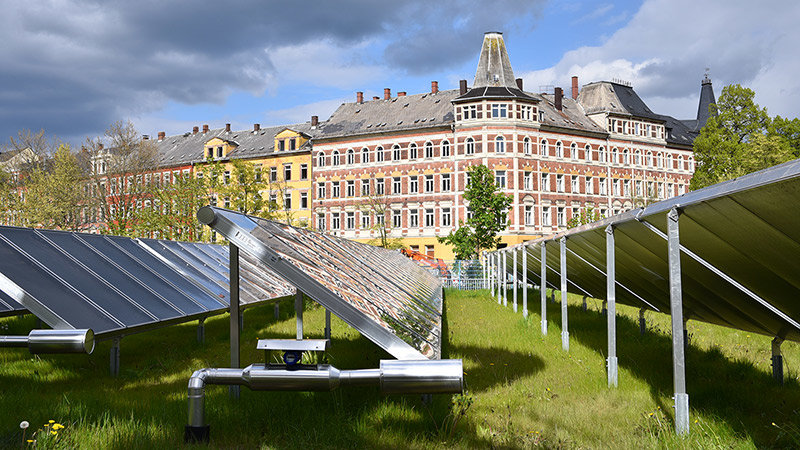Setting an Example: Chemnitz’s Brühl District is Heated with Solar Energy
In partnership with energy provider Eins Energie in Sachsen, the network operator Inetz, and the City of Chemnitz, TU-Chemnitz has developed an environmentally-friendly neighborhood energy concept
 enlarge picture
enlarge picture “All public utilities systems in Germany should be utilizing solar energy for 10% of their district heating load. With this, energy providers can make an important contribution towards protecting the environment and diminishing the impact of rising costs in the future,” claims Prof. Dr. Thorsten Urbaneck, head of the Thermal Energy Storage Group under the Professorship of Technical Thermodynamics at Chemnitz University of Technology (TU-Chemnitz). A shining example of this realistic goal is the Brühl district in the center of Chemnitz. In order to help revive this quarter and its Gründerzeit-era (around the end and the turn of the 20th Century) rectangular housing designs, which are in need of rehabilitation, measures have been introduced within the framework of the Urban Development Support Program “Active City and District Centers”. One of these measures is a new energy supply, a measure that was developed and successfully implemented by the Professorship of Technical Thermodynamics, along with the electric utility provider Eins Energie in Sachsen and its network operator Inetz, as well as the city of Chemnitz. The initial spark for this was the urban development efforts of the city of Chemnitz. Leading the way with this holistic approach was the conversion of the former Aktienspinnerei (Spinning Mill) to the TU-Chemnitz Central Library, a conversion in which the Free State of Saxony played a prominent role.
Ecological heat comes via “parcel service”
The particularities of this concept: “The energy supplier of the approximately 10 acre area of Brühl was decoupled from existing district heating schemes and a new low-temperature power grid was constructed, so that a large solar-thermal structure could be embedded,” reports Ulf Uhlig, departmental manager at Inetz. The neighborhood energy concept for Brühl is a unique model, and is one of 12 projects of energy-based urban redevelopment of the Federal Ministry for Building Development. Already in 2016, the solar-thermal production and thermal storage facilities were put into operation in close proximity to Brühl, on Georgstraße. To date, more than 4 kilometers of district heating groundwork has been laid. “Currently, nearly 200 houses in the district with around 1,300 individual dwellings are heated by solar energy, and further customers are to follow. An equivalent of 100,000 liters of heating oil can be saved each year,” explains Uhlig about the sustainable aspects of the project. The renters receive Earth-friendly heat, by a quasi-“pneumatic pipeline”, without having to worry about complex technological issues. And the building owners get by with a typical thermal insulation of their buildings, as the facades and overall feel of the neighborhood are preserved.
From a technical point of view, the low-temperature power grid in this neighborhood functions quite simply: “The sun warms the districts’ heating water to more than 70 degrees Celsius in 2 collector-fields with a total area of 2100 square meters,” explains Uhlig. Depending on needs, the hot water is either temporarily stored in a 1000 cubic-meter thermal storage unit, or fed out directly to the district heating network of Brühl via insulated pipelines. “If there is not sufficient solar power, for example in the winter months or during persistent cloud cover, energy from the return-flow of the central heating network will be used to heat the water,” says Uhlig.
Chemnitz pilot project causes quite a splash nationwide
“Until 2020 about 10 million Euros will flow in the heating supply of Brühl, including about 1.8 million Euros worth of federal, state, and city subsidies. At the same time, since 2010 we have needed around 12 million Euros to renovate the buildings and upgrade the infrastructure. We have made room for a one-of-a-kind practice space for musicians in an empty school, and supported creative ideas that were given to us after consulting with young people in Brühl,” explains Grit Stillger, Department Manager for City Renewal in the City Planning Office. The energy provider Eins invested roughly 700,000 Euros in the new solar-thermal facility directly on the Chemnitz River. According to Uhlig, “through this facility an annual 313 tons of CO2 emissions can be avoided, as opposed to conventional types of heating.” Urbaneck adds, “in the future, when more renewable energy is fed into this district heating grid, this percentage will of course increase.”
“The technical implementation is already sophisticated. Clearly, implantation would seem to be more difficult with many different actors, however this went quite well in Chemnitz. Last autumn, there was great interest in our city from other local governments, who wanted to learn of the experiences of reconfiguring an entire district. Here, Chemnitz takes a leading role,” says a satisfied Uhlig. “The Ministry of Construction from Nordrhein-Westfalen asked me to present our Brühl neighborhood energy concept as a starting point for the local governments of Nordrhein-Westfalen,” added Stillger. “We are proud that with such innovative projects and partners we were able to receive the European Energy Gold Award.” “I am pleased that the Chemnitz pilot project is taking place throughout Germany and furthermore, in schools,” says Urbaneck. Those who are interested in knowing more about the concept and its accompanying research can gladly contact Urbaneck.
Further information on the research of the Professorship of Technical Thermodynamics: https://www.tu-chemnitz.de/mb/TechnThDyn
Background information on the long-term monitoring of the Brühl power supply and on the operational optimisation of the heating supply system with modern mathematical methods: www.solfw.de and www.wn-navi.de
Contact: Prof Dr. Thorsten Urbaneck, Professorship of Technical Thermodynamics, phone number +49 371 531-32463, e-mail Thorsten.urbaneck@mb.tu-chemnitz.de
(Author: Mario Steinebach, Translation: Jeffrey Karnitz)
Mario Steinebach
06.11.2018





